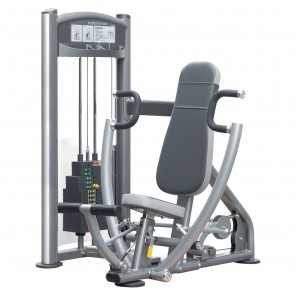Machine weights = weight machines = resistance machines. Whatever you call them, they’re found in all traditional gyms. They usually target one muscle group, but some target a number of muscles at the same time.
There are some basic exercises you can do with these.
Pros
- Easy for beginners to learn & use
- Isolate muscles efficiently
- Good for rehabilitation following an injury
- Can lift heavier weights without assistance
Cons
- Neglect smaller stabilizing muscles
- Non-functional
- May cause injury directly and indirectly
- During peak hours a spare machine maybe hard to find
A machine puts you in the correct position and takes the place of supporting (“helper”) muscles in your body, called stabilisers. They are a safe option as they guide you through the correct range of motion & reduce the chance of injury!
While good for training size and strength, machines neglect the stabilisers. For example, a chest press (performed using a machine) uses the chest muscles. Whereas a bench press (same movement but performed on a bench with free weights) uses the chest AND triceps muscles.
The verdict? Machines should be used as part of your workout, not your entire workout.
Basic exercises
Chest Press
 Sit down on the chest press and ensure the handles are at chest height. Select the weight and use the foot press to extend the handles past your chest.
Sit down on the chest press and ensure the handles are at chest height. Select the weight and use the foot press to extend the handles past your chest.- Grab the handles (with a low palm grip, shoulders down and elbows at chest height) and extend your arms out (this is the start position).
- While breathing in bring the handles back until your hands are level with your chest and hold this for one second.
- While breathing out push the handles back to the start position.
- Once complete use the foot press to return the handles back.
Lat Pulldown
 Sit on a pull down machine and adjust the knee pad so your knees are at 90 degrees and feet flat on the floor.
Sit on a pull down machine and adjust the knee pad so your knees are at 90 degrees and feet flat on the floor.- Adjust the weight, hold the bar with arms fully extended and return to the seat (this is your start position).
- Ensuring you shoulders are held down & back (while breathing out) pull the bar down until it touches your upper chest and hold this position for one second. Focus on contracting your back muscles at this point.
- While breathing out at a steady pace return to the start position.